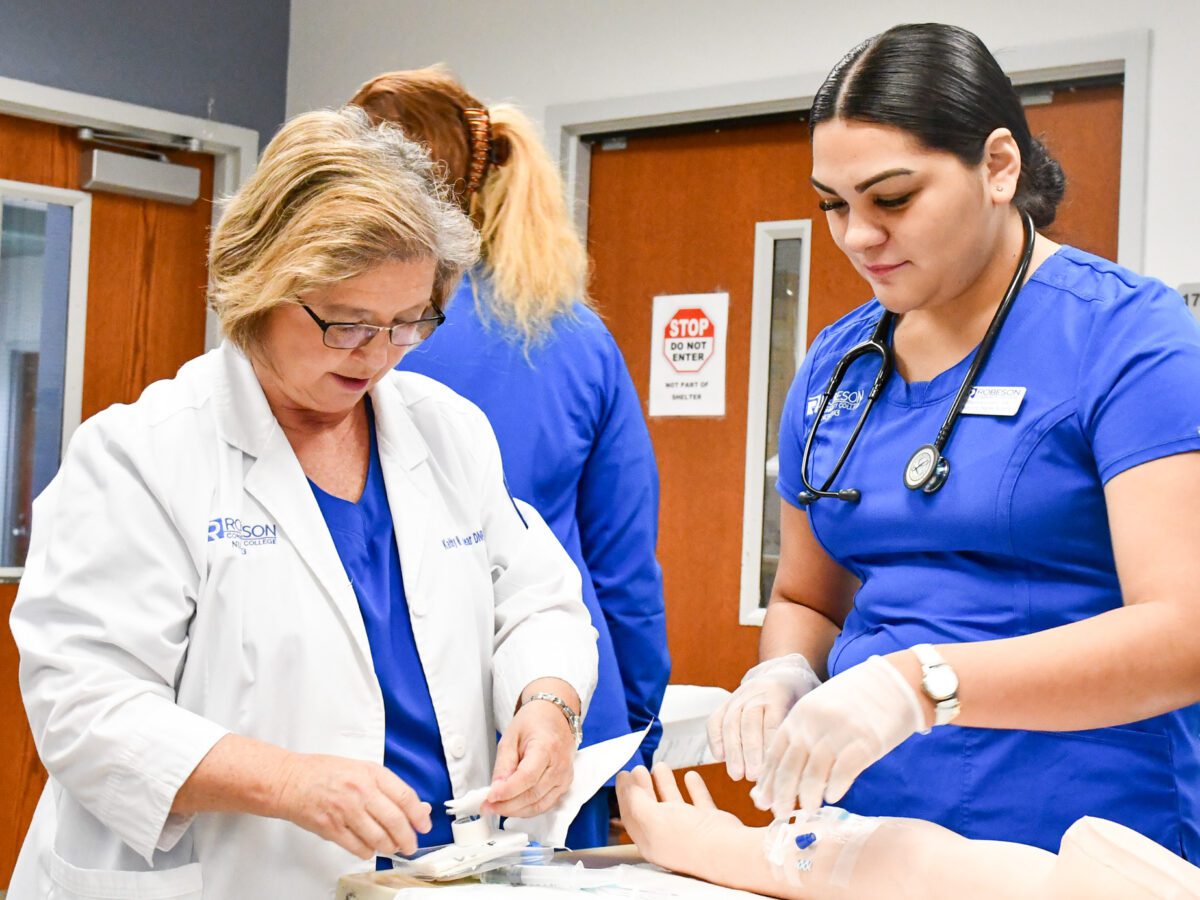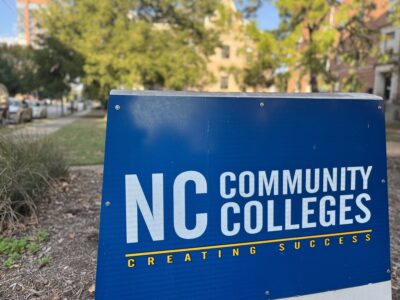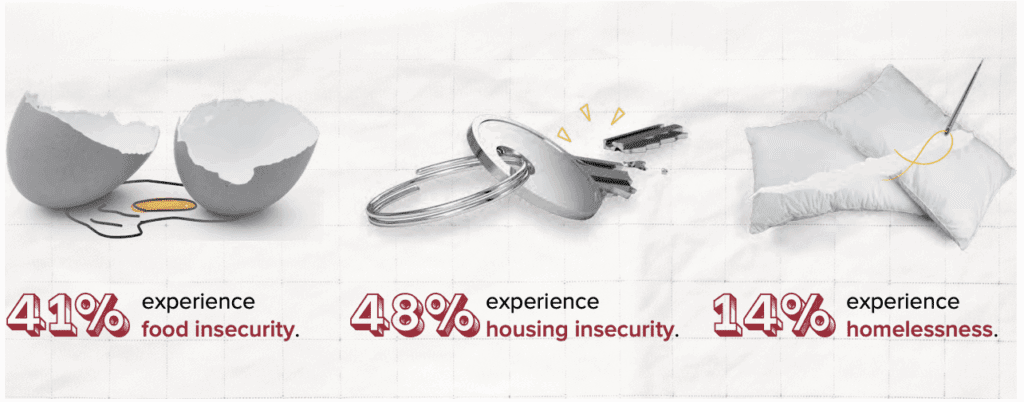
As students head back to school this fall, more and more are choosing to enroll in one of North Carolina’s 58 community colleges. With record enrollments and statewide initiatives focused on improving student outcomes, these institutions are doubling-down on their efforts to meet the needs of their communities.
At the same time, the state’s community colleges are navigating shifts in workforce demands driven by technological change, including artificial intelligence (AI); shifts at the federal level, including the expansion of Pell Grants for short-term workforce programs; and evolving student needs.
The North Carolina Community College System (NCCCS) is also entering this school year in transition. On Aug. 1, system president Jeff Cox announced his retirement effective June 30, 2026. Cox has served as president since June 1, 2023, and he is the system’s 11th president. In the last 10 years, seven leaders have held the position of interim president, acting president, or president of the NCCCS.
Here’s a look at some of the big issues impacting our state’s community colleges as the new school year begins.
![]() Sign up for Awake58, our newsletter on all things community college.
Sign up for Awake58, our newsletter on all things community college.
Enrollment continues to climb at community colleges
It’s too soon to know where fall enrollment numbers will land for North Carolina’s community colleges, but early reports from individual colleges point to another solid year.
Johnston Community College set a new enrollment record with their highest-ever curriculum headcount this fall. On day one of classes, the college reported 6,513 degree-seeking students, a 15% increase compared to fall 2024 and a 61% growth in curriculum enrollment since 2021, according to a press release from the college. The release also noted another record-high — 2,038 dually enrolled students this fall.
Wake Technical Community College (Wake Tech) had the highest enrollment in the college’s history this fall, with 28,600 degree-seeking students on their first day of classes. That number reflects nearly 3,000 more students than last fall, an 11% increase. According a press release, more than 9,500 of those students are new to Wake Tech — also setting a record.
Some colleges in western North Carolina are also seeing steady or increased fall enrollment numbers. This is of particular interest given the impacts of Hurricane Helene in 2024.
“This is more than just getting students into or returning to the classroom. It’s about the community’s resiliency and awareness that moving forward with their education is important to them and their families, no matter the challenges they may face.”
– Michelle Harris, director of engagement and marketing at Haywood Community College
Preliminary enrollment numbers at Asheville-Buncombe, Blue Ridge, Haywood, and Isothermal community colleges show enrollment increases or enrollment that is comparable to fall 2024.
“Seeing HCC’s numbers for fall enrollment this year reminds us how important it is to retain students as well as attract new students,” said Michelle Harris, director of engagement and marketing at Haywood Community College. “With our team effort and funding to support students, seeing enrollment numbers for the fall stabilize compared to last year is very encouraging.”
College leaders impacted by Hurricane Helene said that state disaster recovery funds and private donations were key to retaining students from fall 2024 to spring 2025.
Continued enrollment increases are good news after the sharp enrollment decline both nationally and in North Carolina during the COVID-19 pandemic. Last year, 632,002 students were enrolled in the NCCCS, up 3% from the previous academic year.

Nationally, total postsecondary enrollment grew 4.5% in fall 2024 and was up 5.8% at community colleges, marking the first semester that postsecondary enrollment rebounded above pre-pandemic numbers, according to the National Student Clearinghouse Research Center (NSCRC). Enrollment in undergraduate certificate programs saw a 9.9% increase in fall 2024, marking growth for the fourth year in a row.
In spring 2025, national postsecondary enrollment increased 3.2% compared to spring 2024. Community colleges saw the largest enrollment growth at 5.4% and accounted for 55.8% of the undergraduate enrollment growth. Undergraduate certificate program enrollment increased by 4.8%, making it 20% higher than in 2020, according to NSCRC.
What’s driving enrollment increases across North Carolina?
Most community college leaders will tell you there’s no silver bullet when it comes to increasing enrollment. However, there are various efforts being made across North Carolina to enroll and retain students.
Dual enrollment
Dual enrollment continues to be a driver of overall enrollment, especially at community colleges. Career and College Promise (CCP), North Carolina’s dual enrollment program, is designed to connect students to college and career goals, whether they intend to transfer or go directly into the workforce after high school graduation.
Eligible students can choose between three different pathways under CCP:
- College Transfer Pathways (CTP): tuition-free courses toward a number of transfer degrees, including the Associate in Arts and Associate in Science.
- Career and Technical Education (CTE) Pathways: tuition-free courses toward a certificate or diploma. These include Workforce Continuing Education (WCE) courses that can lead to a state or industry-recognized credential.
- Cooperative Innovative High Schools (CIHS): high schools typically located on college campuses that provide opportunities for students to complete an associate degree or earn up to two years of college credit within five years.
Since 2013, CCP has grown from just over 11,000 students to almost 86,000 during the 2023-24 school year, according to an annual report to the General Assembly.
A recent study showed students who participated in CCP had higher high school graduation rates and higher postsecondary enrollment rates than those who did not. Additionally, economically disadvantaged and underrepresented students benefit most from CCP participation.
Adult learners
Adult learners, or students over the age of 25, make up about 55% of enrolled students in the NCCCS. In recent years, the state’s community colleges have made concerted efforts to engage or reengage this student population.
One initiative that has sparked operational changes within these schools is NC Reconnect, a collaborative effort focused on helping North Carolina’s community colleges engage, reenroll, and credential adult learners. The initiative launched in 2021 with support from the John M. Belk Endowment (JMBE) and aims to “improve workforce opportunities and quality of life for adult learners across the state.”
The statewide effort started with five community colleges and now includes a total of 24. Since its launch, NC Reconnect has reached out to 42,971 adult learners who stopped out, and nearly 3,000 adult learners have returned to continue their education as of spring 2025.
Next NC Scholarship
Finances are still a hurdle for many students seeking to enroll in a postsecondary institution. A new scholarship in North Carolina, launched in 2024, has helped remove that obstacle for many.
The Next NC Scholarship combines state funds and the Federal Pell Grant to offer free community college tuition for North Carolina students with an adjusted gross income of $80,000 or less. The scholarship also covers at least half of UNC System tuition.
Qualifying students enrolling in any of the state’s 58 community colleges can receive at least $3,000 for tuition and fees, and students enrolling in any of the state’s 16 public universities will receive at least $5,000 for tuition and fees.
NC College Connect
NC College Connect is a new program that grants direct admission to select participating colleges and universities for North Carolina public high school students, provided they meet the program’s requirements. Eligible students will see a customized list of institutions in their College for North Carolina portal based on their GPA.
Through the program, seniors enrolled at a North Carolina public school during the 2025-26 school year with a weighted GPA of 2.8 or above, and who meet the NC College Connect requirements, are directly admitted to select North Carolina colleges and universities.
Read more



A renewed emphasis on workforce development
There’s been considerable attention on workforce development and training in recent years, with a laser focus on programs and funding that create pathways to employment.
Nationally, the country has struggled to return to its pre-pandemic employment trajectory. Even in states that have seen employment rebound, like North Carolina, many of the jobs that came back are not the same ones that disappeared.
As of July 2025, the national unemployment rate was 4.2%, and the number of unemployed individuals totaled 7.2 million.
A recent report from the Federal Reserve Bank of Richmond (Richmond Fed) noted that the rate of individuals looking for jobs with no previous work experience rose to 13.4% in July 2025, the highest rate since April 1988.
The Richmond Fed said one possible driver of the increases may be “a high level of uncertainty surrounding trade policies.” Economic research, they say, has found that such uncertainty can affect businesses’ hiring and investment plans.
At the recent NC Chamber Education and Workforce conference, Stuart Andreason, executive director of programs at the Burning Glass Institute, attributed the challenge for first-time job seekers to AI replacing many entry-level positions.
North Carolina, however, is faring better economically than the country overall — the state’s unemployment rate in July was 3.7%, increasing 0.1% from the previous year.
In July, North Carolina was named the top state for business by CNBC for the third time in the last four years.
And business isn’t the only thing booming.
By 2030, North Carolina is projected to be the seventh most populated state in the country, reaching a population of 11.7 million.
In 2024, the North Carolina’s Labor & Economic Analysis Division (LEAD) projected that the state will add over 500,000 new jobs between 2022 and 2032.
With these projected workforce demands, several initiatives are underway at the federal and state level to put more people into postsecondary pathways that lead to the workforce.
The federal government’s cross-agency approach to workforce development
The Trump administration published a report in August 2025, America’s Talent Strategy: Equipping American Workers for the Golden Age, detailing the federal government’s cross-agency approach to workforce development.
The strategy promises access to new career pathways and innovative workforce-based programs and “lays out a comprehensive plan to address the workforce needs of American companies, integrate existing workforce development systems to maximize efficiency and effectiveness, provide accountability for workforce training programs, upskill incumbent American workers, and develop alternatives to 4-year college degrees,” the report says.
The 27-page strategy consists of five pillars:
- Demand-Driven Strategies | “Expand proven work-based learning models like Registered Apprenticeships and align education programs to career pathways in priority industries to ensure direct connections to employer needs.”
- Worker Mobility | “Bring more Americans into the labor force by identifying skills and credentials for in-demand jobs and connecting them with personalized support, including through AI-powered tools, to help them advance.”
- Integrated Systems | “Streamline federal workforce development programs to empower states, unify access points to the system for workers and businesses, and advance the President’s proposal to Make America Skilled Again.”
- Accountability | “Improve transparency and accountability for federally funded workforce programs by improving mechanisms for measuring success and redirecting funding to programs that are proven to connect Americans with good-paying jobs.”
- Flexibility and Innovation | “Ensure the workforce is prepared to adapt quickly to an AI-driven economy by prioritizing AI literacy, creating new pathways to AI jobs, and fueling rapid reskilling and other innovation pilots.”
“We have developed a concrete plan to put the American Worker First,” said U.S. Secretary of Labor Lori Chavez-DeRemer. “Together, we will ensure our workforce is prepared to fill the hundreds of thousands of good-paying, in-demand jobs.”
Pell Grants for short-term workforce training
Beginning in July 2026, eligible students will be able to use Pell Grants for tuition, fees, and other expenses in short-term workforce training programs. The Workforce Pell Grant Program will provide federal financial aid to students enrolled in high-quality job training programs, some as short as eight weeks.
Previously, Pell Grants could only cover costs for curriculum-based programs lasting 15 weeks or more. The new Workforce Pell Grant provisions were part of the Consolidated Appropriations and Workforce Investment Act passed in June 2025.
This is a long-awaited moment for North Carolina’s 58 community colleges that offer numerous short-term workforce training programs across in-demand industries and fields.
U.S. Sen. Ted Budd, R-NC, introduced the legislation earlier this year, saying these programs allow students to earn credentials needed to access high-quality, family-sustaining jobs in just eight weeks, according to a NCCCS press release.
A new Council on Workforce and Apprenticeships in North Carolina
In North Carolina, Gov. Josh Stein created a new Council on Workforce and Apprenticeships in March 2025.
“Our state’s greatest asset is our people, and to invest in our future, we must invest in our people. No state will outwork North Carolina when it comes to developing our workforce,” Stein said during his announcement of the new council.
The council is responsible for identifying workforce needs and amplifying strategies that help North Carolinians access the education and training needed for high-wage, high-demand, and high-growth careers. The group consists of leaders from business, education, labor, and state agencies.
The council has identified 11 goals to help grow and prepare the state’s workforce development efforts over the next four years. The goals address several topic areas, including credential and degree attainment, labor market alignment, apprenticeships, work-based learning, sector-based strategies in emerging areas, and state government employment.
The council was also tasked to consider opportunities to support people in “rural communities, those who have been justice-involved, people with disabilities, and veterans and their families.”
By Dec. 15, the council said it will have identified strategies to attain each of the recommended goals. All goals are on a four-year timeline, and annual progress reports will be submitted each December starting in 2026.
Boost and Propel NC
Funded by a $35.6 million grant from Arnold Ventures, Boost is an accelerated college-to-career program designed to increase completion rates and move students into high-wage, high-demand jobs by providing them with timely and relevant support, dedicated student advising, and financial incentives. Boost is launching this fall at eight community colleges, followed by seven more next year.
The first statewide replication of the CUNY ASAP model, a nationally acclaimed and evidence-based program that has proven its ability to increase three-year community college graduation rates, Boost will have a particular emphasis on contributing to North Carolina’s workforce needs. Eligible students are required to be enrolled in degree programs that the NCCCS’ proposed new funding model, Propel NC, identifies as being in-demand fields.
Apprenticeships continue to grow
Apprenticeships are the center of many workforce development conversations. While there’s nothing new about apprenticeships, the “earn while you learn” model has been making a comeback over the years, gaining support at the federal and state level.
As of March 2025, there were 10,617 active apprentices and pre-apprentices through ApprenticeshipNC, the state’s apprenticeship program, in addition to 2,225 national programs located in the state.
Since 2015, the federal government has distributed hundreds of millions of dollars annually to expand apprenticeship programs through the U.S. Department of Labor (DOL).
In June 2025, the DOL announced $84 million in grants to advance the expansion of registered apprenticeships. NCCCS was awarded over $1 million of the $84 million to strengthen ApprenticeshipNC.
In its 2021 biennium budget, the North Carolina General Assembly included $12 million to expand apprenticeships in the state to individuals ages 16 to 25. The funding supports small businesses (no more than 500 employees) working with one of the 50 eligible community colleges serving Tier 1 and Tier 2 counties.
Employers receive up to $2,000 per apprentice for onboarding and training and a 50% salary reimbursement on wages up to $15 per hour for non-high school students and $14 per hour for high school students. Colleges receive up to $2,500 per apprentice for tuition, books, fees, and supplies. These funds had to be obligated by Dec. 21, 2024 and must be fully dispersed by Dec. 31, 2026.
As of March 2025, this funding has contributed to the registration of 1,385 apprentices between the ages of 16 and 25 for 155 employers by ApprenticeshipNC.
In July 2025, ApprenticeshipNC announced a new funding opportunity available to registered apprentices. The Short-Term Workforce Development Grant (STWD) “provides financial assistance for students enrolled in skills training programs at any of North Carolina’s 58 community colleges,” a press release says. Those who are eligible can receive grant funding up to $750 per course to cover “training expenses, including tuition, fees, books, supplies, credentialing tests, transportation, and childcare.”
Yet even with multiple funding streams, a shortfall remains.
Chris Harrington, director of ApprenticeshipNC, said in a March press release that nearly 700 apprentices from 170 employers remain on a waitlist for funding to implement registered apprenticeship programs, with approximately $14 million needed to fund the current waitlist.
Funding isn’t the only challenge.
Employers interested in becoming an official apprenticeship sponsor are met with significant paperwork and red tape. Employers say the process is cumbersome and overwhelming, noting the difficulty of interpreting some of the language from the U.S. Department of Labor.
Several community colleges in North Carolina, including Davidson-Davie and Forsyth Technical, have opted to serve as the sponsor for apprenticeship programs, partnering with employers by taking on administrative tasks. While this alleviates some of the burden on employers, it likely isn’t a sustainable model, particularly for smaller schools.
Recently, the State Board of Community Colleges gave initial approval for a new policy recommended by the ApprenticeshipNC Council that would establish criteria for registering pre-apprenticeship programs in North Carolina. The rationale for the new policy includes a lack of clear guidance on how pre-apprenticeship programs should operate, failed connections between pre-apprenticeship programs and registered apprenticeship programs, geographic disconnects, and insufficient training.
The recommended policy will be discussed among the North Carolina Association of Community College Presidents (NCACCP), followed by a 30-day public comment period. The chair of the Programs and Student Success Committee said the Board will likely vote on the policy in October 2025.
Read more



Basic needs insecurity persists among students, and looming cuts could make it worse
On a panel at last year’s adult learner conference hosted by the NCCCS, Camika Williams, an adult learner at Guilford Technical Community College, said, “Ask the hard questions. Are you homeless? Are you hungry?”
Community college students continue to share that oftentimes their barriers to enrollment and completion aren’t academic at all. Instead, some of the most common barriers include limited access to basic needs.
Between spring 2023 and summer 2024, the Hope Center for Student Basic Needs surveyed 74,350 individuals across 91 colleges and universities in 16 states. The survey findings revealed that 59% of students experience at least one form of basic needs insecurity.

According to the report, those who struggle to access and afford higher education tend to be the same ones who experience basic needs insecurity.
A similar study by Trellis Strategies, and presented to the NCCCS in July, found that 56% of student respondents from two- and four-year colleges across the U.S. said they would have trouble obtaining $500 in the event of an unexpected expense.
Additionally, 58% of respondents have limited access to nutritious food and stable housing, and many are facing mental health challenges. Of those surveyed, 57% indicated they always feel lonely, 33% reported symptoms of major depressive disorder, and 44% described symptoms of a generalized anxiety disorder.
These challenges can be even more common at community colleges given that many of them enroll diverse student populations. A large portion of community college students are low-income, first-generation college-goers, which adds to the complexities of their enrollment and retention.
While community colleges continue to adjust their operations and embed student supports that extend beyond academics, there is looming concern among higher education leaders that the expansive federal budget reconciliation bill passed by Congress in July will cut through the federal safety net that many in North Carolina and across the country rely on.
An estimated 520,000 North Carolinians could lose their health insurance, according to a press release from Gov. Stein, and Medicaid cuts could have a significant impact on community college students, many of whom are low-income.
In the same press release, Stein says that cuts to SNAP are “equally serious,” and an estimated 1.4 million North Carolinians, including 600,00 children, could lose food assistance if the state cannot fund its share of the program.
While it’s unclear how these federal cuts will play out in the months ahead, what is clear is that community colleges serve students with varying needs, and providing non-academic supports is essential to their postsecondary success.
Editor’s note: The John M. Belk Endowment and Arnold Ventures support the work of EdNC.
Recommended reading


